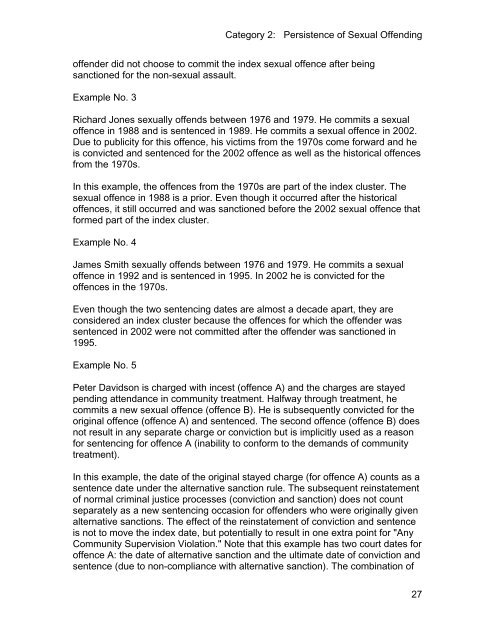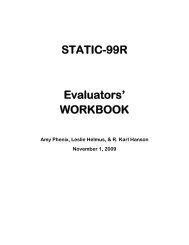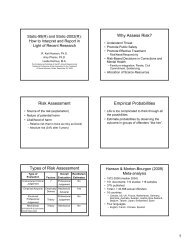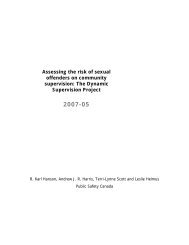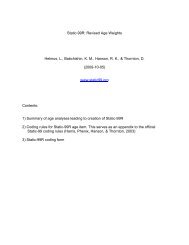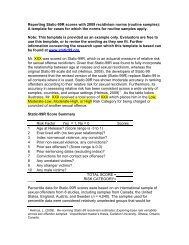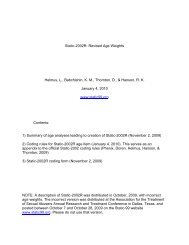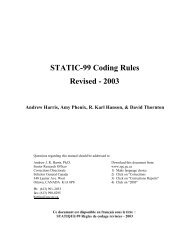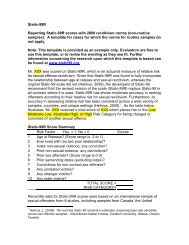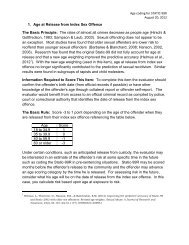Static-2002 coding rules (2009) - Static-99
Static-2002 coding rules (2009) - Static-99
Static-2002 coding rules (2009) - Static-99
You also want an ePaper? Increase the reach of your titles
YUMPU automatically turns print PDFs into web optimized ePapers that Google loves.
Category 2: Persistence of Sexual Offending<br />
offender did not choose to commit the index sexual offence after being<br />
sanctioned for the non-sexual assault.<br />
Example No. 3<br />
Richard Jones sexually offends between 1976 and 1979. He commits a sexual<br />
offence in 1988 and is sentenced in 1989. He commits a sexual offence in <strong>2002</strong>.<br />
Due to publicity for this offence, his victims from the 1970s come forward and he<br />
is convicted and sentenced for the <strong>2002</strong> offence as well as the historical offences<br />
from the 1970s.<br />
In this example, the offences from the 1970s are part of the index cluster. The<br />
sexual offence in 1988 is a prior. Even though it occurred after the historical<br />
offences, it still occurred and was sanctioned before the <strong>2002</strong> sexual offence that<br />
formed part of the index cluster.<br />
Example No. 4<br />
James Smith sexually offends between 1976 and 1979. He commits a sexual<br />
offence in 1<strong>99</strong>2 and is sentenced in 1<strong>99</strong>5. In <strong>2002</strong> he is convicted for the<br />
offences in the 1970s.<br />
Even though the two sentencing dates are almost a decade apart, they are<br />
considered an index cluster because the offences for which the offender was<br />
sentenced in <strong>2002</strong> were not committed after the offender was sanctioned in<br />
1<strong>99</strong>5.<br />
Example No. 5<br />
Peter Davidson is charged with incest (offence A) and the charges are stayed<br />
pending attendance in community treatment. Halfway through treatment, he<br />
commits a new sexual offence (offence B). He is subsequently convicted for the<br />
original offence (offence A) and sentenced. The second offence (offence B) does<br />
not result in any separate charge or conviction but is implicitly used as a reason<br />
for sentencing for offence A (inability to conform to the demands of community<br />
treatment).<br />
In this example, the date of the original stayed charge (for offence A) counts as a<br />
sentence date under the alternative sanction rule. The subsequent reinstatement<br />
of normal criminal justice processes (conviction and sanction) does not count<br />
separately as a new sentencing occasion for offenders who were originally given<br />
alternative sanctions. The effect of the reinstatement of conviction and sentence<br />
is not to move the index date, but potentially to result in one extra point for "Any<br />
Community Supervision Violation." Note that this example has two court dates for<br />
offence A: the date of alternative sanction and the ultimate date of conviction and<br />
sentence (due to non-compliance with alternative sanction). The combination of<br />
27


